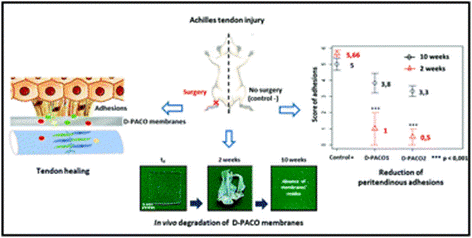
Preliminary in vivo study of biodegradable PLA-PEU-PLA anti-adhesion membranes in a rat Achilles tendon model of peritendinous adhesions
BIOMATERIALS SCIENCE 2022,10, 1776-1786
Hadda, Zebiri, Van Den Berghe Helene, Paunet Tom, Wolf-Mandroux Aurelie, Bethry Audrey, Taillades Hubert, Yohan Jean Noel, Yohan Jean Noël, Nelly Pirot, Botteron Catherine, Chammas Michel, Chammas Pierre-Emmanuel and Garric Xavier
ABSTRACT
Peritendinous adhesions are complications known to occur up to 6 weeks after surgery and cause chronic pain and disability. Anti-adhesion barriers are currently the best option for prevention. In a previous study, we designed two biodegradable membranes, D-PACO1 and D-PACO2, based on new triblock copolymers and conducted in vitro evaluations. The membranes maintained filmogenic integrity, had degradation rates that promoted anti-adhesion and were biocompatible, suggesting their safe and effective use as anti-adhesion devices. To test this hypothesis, we conducted a preliminary in vivo study in a rat model of peritendinous adhesions and evaluated the membranes’ degradation rates, tendon healing and anti-adhesion effect compared to non-surgical and surgical control groups 2 and 10 weeks after surgery. Macroscopic evaluation showed membranes were effective in reducing the extent and severity of adhesions. Membranes acted as physical barriers at 2 weeks and underwent a complete or significant biodegradation at 10 weeks. D-PACO2 had a longer degradation rate compared to D-PACO1, was more effective in reducing adhesions and is expected to be more effective in promoting tendon healing. The tendency of D-PACO1 to promote tendon healing while D-PACO2 did not interfere with healing highlights the need to redesign the porosity of the D-PACO membranes for optimal nutrient diffusion, while maintaining their anti-adhesion effect and clinical usability. Preliminary findings revealed that adhesions form beyond the 6 weeks cited in the literature. In this study, adhesion formation continued for up to 10 weeks, underlining the need to increase the experimental period and sample size of future experiments evaluating anti-adhesion membranes.


